Beauty and the Beast: the first animated feature to be nominated for a Best Picture Oscar. Most of our favourite critics sing this film’s praises to this day, while others accuse it of normalizing domestic abuse.
And, given who our love interest is, we can see why.
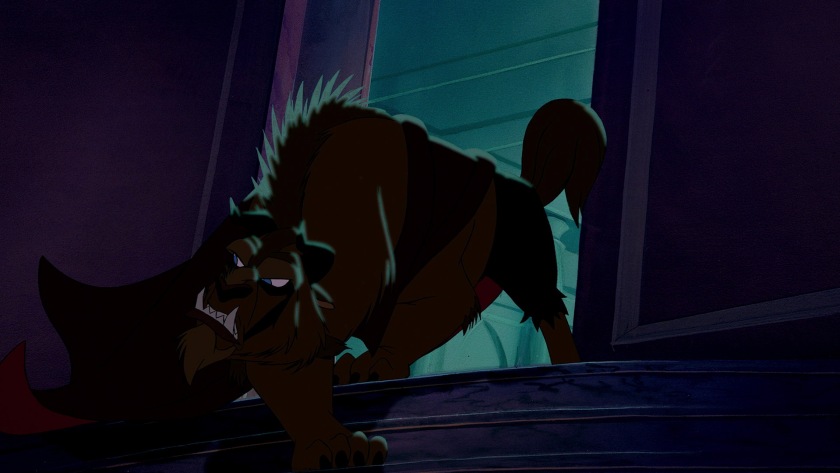
But when we watch Beauty and the Beast, we aren’t concerned for Belle’s safety. Although her imprisonment is obviously wrong, this essentially ends in the scene where Beast saves her in the woods, and she brings him back to the castle to tend to his wolf-wounds.
Frankly, we would have just let him die.
The significance of that is that Belle has reached her breaking point, runs away, and then, after seeing the Beast come to her aid in the wolf crisis, she chooses to return to the castle and take care of him. Although it’s not really the kind of choice we’d prefer our female characters to be offered, it is still a choice. Anyway, after this point we’re shown nothing but positive experiences for Belle in the castle, so… Stockholm Syndrome, this is not. No, this movie commits a different crime, one which we don’t often see people call it out on – outside of the odd well-worded tweet or this Buzzfeed List.
THIS MOVIE MAKES NO GODDAMN SENSE.
Rather than re-listing all of the GAPING PLOT HOLES listed in that Buzzfeed article, let’s go over the bare bones of this movie and how it thematically fell flat for us.
Belle is Blah
Okay, okay, we get it. She’s the first brunette princess. She’s bookish and people don’t understand her. She lives in a fantasy world and is bored to death by reality. All the conventionally attractive blondes are puzzled by her.
Who do you have to be to not see yourself in this character? One of those bimbettes? Because the truth is that each of those blondes probably sees herself as a Belle, too. As The Breakfast Club put it, everyone’s bizarre. Some people are just better at hiding it.
This is not an inherently problematic way to write a character. We like Belle. But just for the sake of discussion, you know who else we like?

Hermione Granger is the Belle that Belle could have been if Belle had been a well-written character. She has ambitions, insecurities, incredible strength of character, annoying flaws that make her kind of a pain to read about sometimes, and lessons that needed learning.
The much-maligned Little Mermaid is also about a girl who is a misfit and has a weird obsession everyone else thinks is stupid, by the way. And although she doesn’t necessarily learn a lesson either, for her, it’s still a coming of age story. Ariel is a flighty young woman who goes out and gets what she wants, in spite of her father’s disapproval. Look at Merida, a spirited girl who makes a huge mistake and has to learn responsibility. Now look at Belle. Belle is dry toast.
And sure, she’s a role model. But we ask you to consider what help a perfect, self-sacrificing young woman is to actual human girls who have real flaws. We’d rather see ourselves in Hermione Granger, whose friends love her even though she’s a know-it-all, or Ariel, who they tried to keep from reaching her dreams, or Merida, who messes up majorly but makes it out with her loving family in tact. Those are helpful stories for girls. What good does Belle do, really, other than tell girls that they ought to give up everything they dream of to save their old father who doesn’t even know how to put on a coat?
But what about Mulan? She gives it all up to save her father.
Both Mulan and Belle feel out of place in their hometowns. But Mulan goes off to war and comes back to her family as a decorated war hero. Belle… goes to a castle-prison and teaches a dude to read. Mulan becomes empowered by her adventure. Belle becomes someone’s wife.
Blah, blah, blah. Look, if you must give us role models, at least allow them to have a story arc that isn’t just teaching some idiot to love.
Beast is Blah
But how? He makes so many dramatic faces.
It’s impossible to say for sure, but erm’s theory for why the Beast doesn’t work as a character – for us at least – is Howard Ashman.
Like, it’s not Howard Ashman’s fault that the character doesn’t work – instead, it’s because they didn’t listen to him that the character doesn’t work. In Waking Sleeping Beauty, which is essential documentary viewing for any Disney renaissance fan, we hear that Ashman wanted the opening of the film to be a fully animated prologue about the Beast as a child Beast. He imagined it as being moving and heart-wrenching, but the film’s directors couldn’t get past an “Eddie Munster image” of a hairy little boy.
Maybe they were right in the end – maybe a Beast child would have looked ridiculous, but the prologue we’re left with doesn’t work. All we glean from it is that as a young man (an eleven-year old, according to the math you can do from watching the prologue and then listening to Ashman’s defiant lyrics in Be Our Guest) the Beast refuses to take pity on an old beggar woman because he doesn’t like the way she looks, and he gets kind of majorly punished for it. As does the entirety of his staff. And his dog. And his cat, if we’re including the addition of Human Again in this analysis.
What comes next for this character? He’s touchy about his assumption that Maurice stumbled into his house to “stare at the Beast” so he locks him in a dungeon to die.
It’s not that we can’t get past this. We’re willing to give the guy a bit of slack, considering he’s been unfairly treated for all these years and as it gets closer and closer to his twenty-first birthday, he’s running out of time to return to his human form. That sucks. If he goes to extremes with Maurice, that’s understandable. Not justifiable, but we expect as an audience that he’ll make up for this behaviour later.
We can also understand his behaviour with Belle once she agrees to take Maurice’s place as his prisoner. “She’s a girl!” he’s thinking. “She can break the spell!” Yes, it was Lumiere who said it, but the difference in how he treats his two prisoners makes it clear that he’s not opposed to trying to use Belle to fix the situation.
And as he never had a chance to properly grow up, the fact that he demands that she will join him for dinner right away makes sense. His insecurities compel him to make a show of force rather than risk being rejected.
Obviously, she does reject him, and his reaction to that is to scream, “THEN GO AHEAD AND STAAAAAAAAAAAAAAAAAAAAAAAAAAAAAAAAAAAAAAAAARVE!” at her door.
https://www.youtube.com/watch?v=4SDjvm_A5Yo
The very next time they meet, he flips out and starts smashing things because she had the nerve to get too close to the rose.
All of this makes sense. It really does. It just has nothing to do with what the prologue told us. What does it have to do with? Ashman’s desired animated prologue about the Beast as a little boy, doomed to beasthood unless he can earn someone’s love, but without a clue of how to go about getting someone to love him.
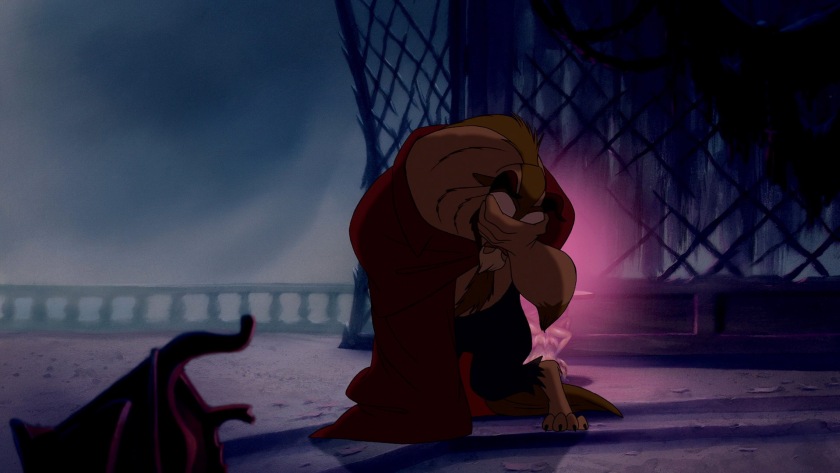
That’s sad. Like, that could maybe have been one of those “like dis if you cry every tim” Disney moments if it had been made Ashman’s way. It makes us feel kind of bad about our attempts to eviscerate the character in the second half of the film. But we’re going to do it anyway.
We’ll never know why the Beast goes after Belle when she takes Philippe and runs. We’re probably supposed to assume that he knew the woods are full of wolves, so he goes out to save her. But his behaviour up until this point makes it equally possible to argue that he may have just gone to collect his prisoner.
It doesn’t matter, or at least the movie thinks it doesn’t matter, because once Belle returns the Beast home and looks after his wolf bites, things between the two start to change.
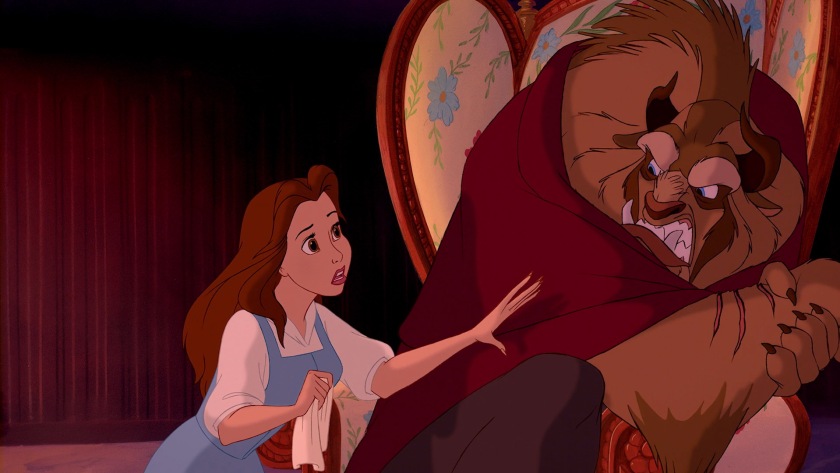
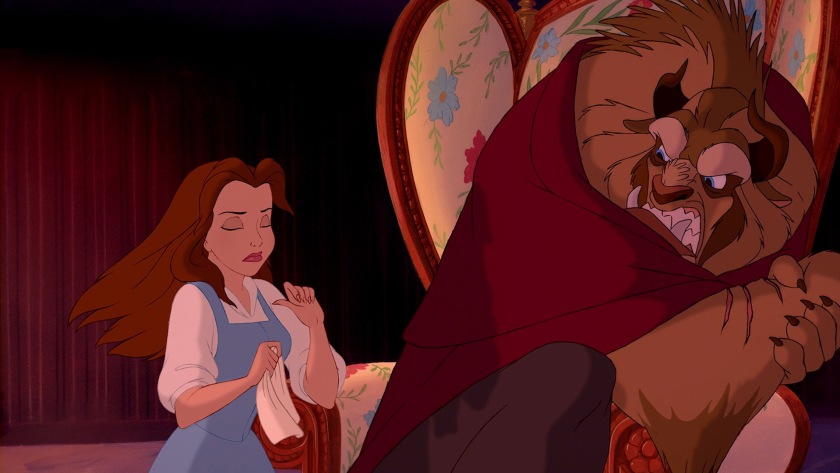
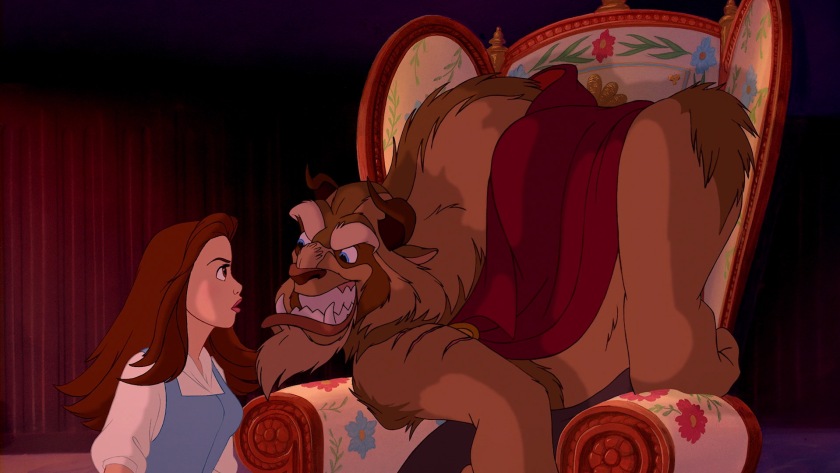
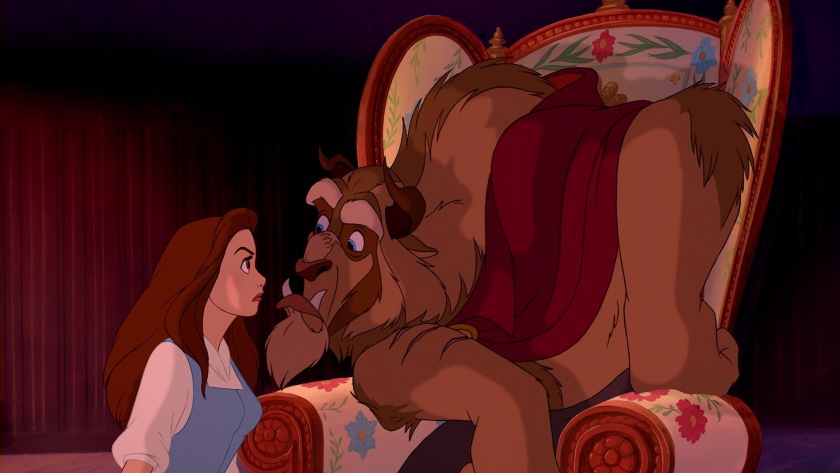
That’s fine. It’s fine and dandy, in fact. But at some point it stops being fine and dandy, and that point is when the Beast decides that Belle can leave to go and help Maurice.
By the way. MAURICE. PUT ON A COAT.
Belle leaves. We know that the Beast’s reaction to this is ridiculous, and that people think she should maybe have told him she’d return at some point, but we think the movie was trying to suggest that she hadn’t decided if she’d ever be back.
Why would she have made this decision at this point, if you really think about it? Currently, her goal is to help her hapless father, and after that, blessed with her freedom and the chance to go find that “adventure in the great wide somewhere,” if she decided to go back to visit her friend and maybe eventually turn their relationship into something romantic, that would be more than fair.
But the plot requires we make everything hyperdramatized for the last twenty minutes, so the last petal of the rose is about to fall, Gaston hears about the Beast’s existence, locks Belle and Maurice up, and leads the handily standing by hate mob to go and “kill the Beast.”
And thus, we get to our problem with the Beast, who is, you’ll remember, redeemed now.
His little old lady teapot housekeeper pathetically hops to his lair and asks, “Master, what should we do?”
And he says, “It doesn’t matter now. Just let them come.”
NO.
Beast. It sucks that some spiteful hag punished you for being a bratty eleven-year-old, but your people got the shaft way worse than you did. You are a giant fighting machine. GO AND PROTECT YOUR PEOPLE.
Even CHIP is more involved in fighting back, and CHIP IS A TEACUP CHILD.
Gaston beats the Beast half to death too, and he just lies there and takes it because his life doesn’t matter anymore now that Belle’s been gone for twenty minutes. That’s a healthy outlook on life, Disney. (Imagine if this character had been female, giving up on life because a man left her? People would be foaming at the mouths, screeching about bad role models for impressionable girls. See: Twilight. Just saying.)
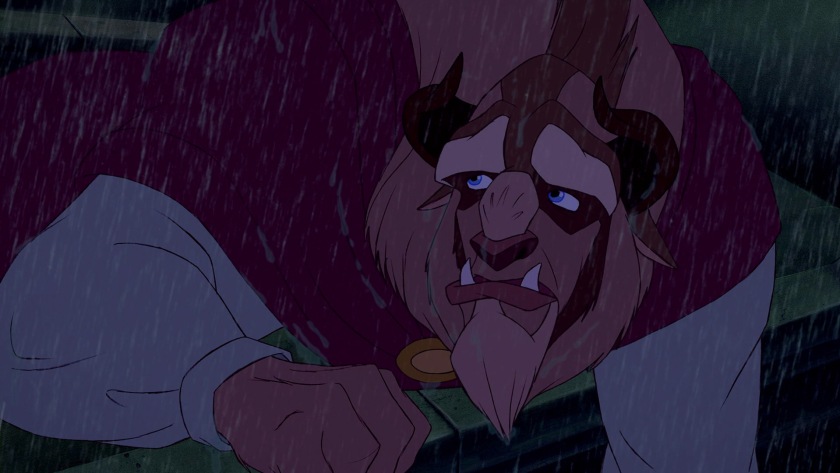
Beast only fights back when he sees that Belle is back. The major character moment of this scene isn’t the fighting back, it’s when the Beast has a chance to kill Gaston but doesn’t. We linger on his face as he makes the decision to spare Gaston, and we finally know that meeting and falling in love with Belle has changed him.
Before, he would condemn a harmless old man to die in his dungeon for imagined insult. Now, a man who just beat him half to death is allowed to live because he’s capable of keeping his temper in check.
Great. Two things, though:
- The prologue said nothing about anger management being his overarching character flaw.
- His temper would have come in real useful back when his people were being attacked. Also it would have helped in the pursuits of protecting his own life just before this.
We’re meant to believe that Belle giving the Beast a heart, “taming” him, making him have empathy for people, is such a great thing, but if he’s literally suicidal and can’t even muster up enough empathy to help his literally objectified staff who are only in this mess because of him, how is this actually a good thing?
Also, if the take-away message of Beauty and the Beast is that outward appearances shouldn’t matter, doesn’t depicting the Beast giving up on life now that he’s doomed to remain a Beast forever RATHER undercut that message?
We hate to say it. We really do. But Shrek did it better, folks. At least in regards to the “appearances don’t matter” theme.
What is Belle’s problem, anyway?
Consider:
https://www.youtube.com/watch?v=vVkbMeA1eV0
https://www.youtube.com/watch?v=6DHN7uGBQDw
Compare this scene to these two versions of it by Todrick Hall:
We think they do a better job of communicating what’s supposed to be going on with this character. In both parody versions Belle would like to fit in, but she really can’t for reasons that go deeper than just “she likes to read and apparently nobody else does.” She also isn’t exactly wrong in either of these versions for looking for more than what she’s surrounded with, as her environments are pretty much wall-to-wall stereotypes. But the videos are also a celebration of those stereotypes, so the little/village people questioning her clueless presence among them is also perfectly fair.
In the movie we get a payoff for Belle’s casual boredom in her poor provincial town when all of those poor provincial lackwits are easily convinced by Gaston that they ought to go lynch some Beast.
https://www.youtube.com/watch?v=ZEvsv6fbtEQ
“We don’t like what we don’t understand, in fact it scares us and this monster is mysterious at least.”
Well that’s blunt.
We can buy the village people being concerned about the Beast’s presence, but suggesting that their mob-mentality is only themeatically important because it plays in connection to their inability to appreciate Maurice’s inventiveness, Belle’s imagination, and books at all, seems a little mean-spirited.
What would the Todrick Hall parody versions of Belle’s provincial town be marching off to destroy?
Probably nothing. Because it doesn’t make sense.
The lynch mob makes real-world sense, ABSOLUTELY it does, but in the spirit of comparing Belle to the people in her community, it just seems a little elitist. A little Ayn Randian too if we’re being honest. Our hero is supposedly the misunderstood genius and everyone around her is just a little worthless closed-minded nothing who contributes only bad things to society. There isn’t even an attempt to see things from their viewpoints.
So WHY is this movie so beloved?
We don’t even have to demand an answer to this from the critics. We need go no further than the comfort of our own home to answer this because WE TOO INEXPLICABLY LOVE THIS MOVIE. Just not enough to suggest that Belle is a more interesting character than Simba (Roger Ebert said that. Roger. Ebert.), or that Beauty has a better protagonist and a better story to tell than The Little Mermaid (Lindsay Ellis) or that Frozen is the best Disney fairy tale since this near perfect mess we’ve just tried to rip into (Bob Chipman).
Simba actually does things, The Little Mermaid is actually about a young woman getting what she wants out of life, and Princess and the Frog and Tangled are better than Beauty. We’d go so far as to include Aladdin in that as well.
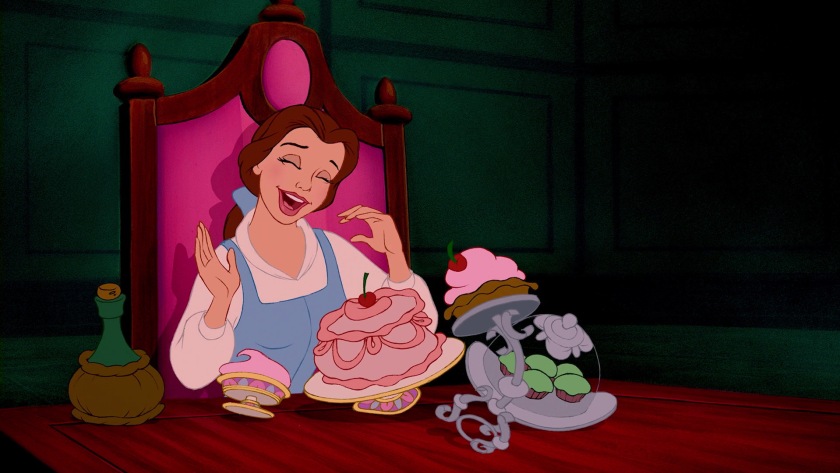
And yet we still love it. We may shout and throw things at the TV screen when the Beast tells Mrs. Potts it’s totally cool if she and all of her children get smashed to pieces, but we love it.
Why? Because this movie is somehow capable of enchanting people like the overzealous enchantress of its prologue. Consider:
- We somehow are compelled to believe that the movie is about a brainy young woman who wants adventure in the great wide somewhere, but Belle is the blank slate to end all blank slates, and the movie is actually all about the Beast learning that it’s more appropriate to give up on life than it is to get angry all the time.
- We somehow are compelled to believe that the Beast is learning a lesson about appearances when all he does is fall in love with THE MOST BEAUTIFUL GIRL IN TOWN and then decides life isn’t worth living if he doesn’t get to return to pretty-boy status.
- We somehow are compelled to believe that “controlling one’s temper” is the same as lying down when someone is trying to kill you. And that this is romantic.
- We somehow are compelled to sympathize with Belle’s uber boredom when really, these people are just trying to live their lives and can’t afford to be idly reading at every moment of the day.
- We somehow are compelled to believe that Belle is a good role model for girls, unlike all the other Disney princesses, even though her story arc is sacrificing herself to save her father and then making the most of her imprisonment by teaching an enraged man-child how to love.
- We somehow are compelled to not notice the major character stumble evidenced in that Belle will give up her freedom and be the Beast’s prisoner to free Maurice from his dungeon, but won’t marry Gaston to save her father from being imprisoned in a questionable psychiatric facility.
How is this magic possible? It is probably because every scene of this beautiful, magical film is perfect. EVEN the scene we hate where the Beast is like, “You think you’ve got problems, tiny teapot? I just had to watch my one chance at human form ride off and now I have only two choices: die by convenient hate mob, or learn to accept my beastly appearance. Have fun raising your teacup children. That is, if they aren’t all smashed to pieces in this lynch mob fiasco I won’t help you with.”
It’s beautiful because he’s so emotive and in pain and it’s sad, it really is.
But then you start to think about it and you realize that this movie has no reason to just pretend to be perfect.
It could have actually truly been perfect, if it had actually been about what it keeps saying it’s trying to be about.
For example: the Beast could have a moment where he decides that being a Beast isn’t so bad. Without this, the movie simply isn’t about asking us to look beyond appearances. We could have Belle confront her ego, or even just her quixoticness, so that she could have a flaw to work through as well. That Ashman prologue we went on about would have helped give the Beast meaningful character development. We could have even just taken Belle’s dream seriously, like Mermaid did, and given her an opportunity to revisit it even once after the opening songs.
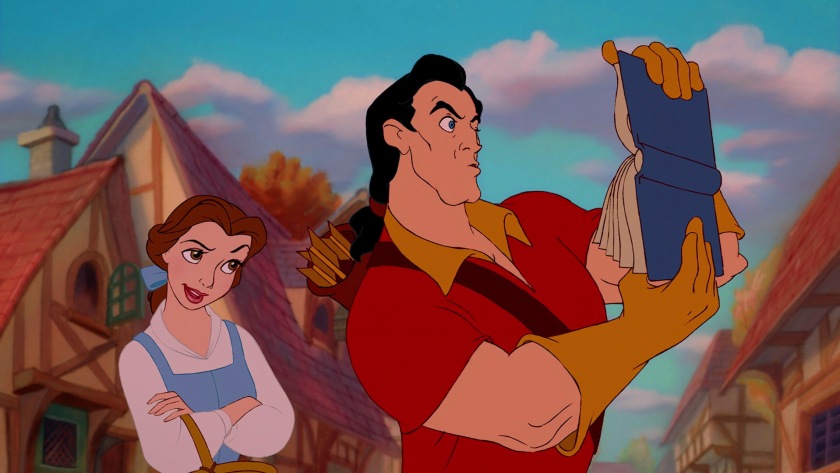
Closing Arguments
Okay, so we’ve picked apart a beloved childhood memory and shone some light on what we feel are its major flaws – boring main characters, a lack of thematic continuity, and some problematic writing as far as the villagers are concerned. And despite all that, we still love this movie, for a variety of rational and irrational reasons.
Could it have been done better? Absolutely. And let’s hope they get it right this time.
But in the meantime, we’ll take Beauty and the Beast as is. We have our favourite songs, an incredibly relevant villain, some beautiful animation, and a story that is so captivating that it caused us all not to notice that it made no sense whatsoever. We’d call that an unqualified success, as Disney movies go.
It’s still not better than the Lion King, though.




[…] adults. Instead, it’s a little more like Beauty and the Beast which absolutely did not commit to its supposed “looks don’t matter” overarching […]
[…] and forward have started stepping up for what they want out of life (with the exception of Belle). Ella of 2015 has more in common with these newer princesses than she does with her 1950’s […]
[…] three masterpieces: I Want: Our Guide to Disney Princesses, In Defence of Mr and Mrs Arendelle, Beauty and the Beast, The Ethics of the Sun’s Gift, and because I wouldn’t feel right talking about erm and […]